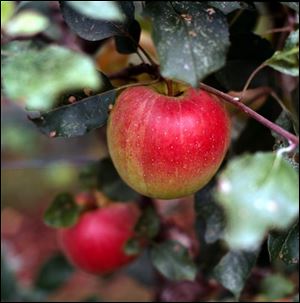
Fine fruit starts with healthy buds
3/30/2005Have you walked by your apple or pear tree lately? The buds are starting to get fatter. The trees are waking up and the fruit is showing signs of life.
If you don't mind a few blemishes on the fruit, keep the crop free of chemicals. Many fruit and vegetable growers don't like to use pesticides or fungicides on crops they will consume. Knocking a few buds off the branches this spring will help the fruit grow larger. Keeping the weeds down around the trees and thinning the branches will help those trees to stay vigorous and focused on making fruit, not foliage.
If you like to grow blemish-free fruit like you see in the grocery store, you'll probably need to fend off the fungus and insects with some chemical sprays.
Watch buds for signs of growth that indicate the four spraying steps. Buds will swell, develop green tips, change colors, and drop their petals.

Spraying to protect fruit from pests and diseases starts in early spring, when tiny buds are on the trees.
Ohio State University experts recommend spraying apple, crabapple, pear, and quince trees before the buds swell. The first spraying should be with dormant oil, which helps control mites and scale that have been on the trees through the winter. Horticultural oil is available at home and garden centers. Only spray the trees when the temperature will be above freezing for at least 24 hours. Some orchardists like to wait until the temperatures reach 40 to 50 degrees. If the buds on the trees have started to grow, but are still small, use delayed-dormant spray. This can be applied while the tip of the bud is green until it is about a half inch long.
If it rains more than a half inch, the spray will be washed off and should be reapplied. Spray within 24 to 48 hours after a heavy rain to protect the buds.
Within a few weeks, when the buds are about a half inch long with little green tips, spray the trees with captan (a fungicide) and diazinon (an insecticide).
Insect pests are starting to appear now, and many will be more active in April. May is the time to apply an insecticide to fight aphids, red mites, and curculio. Spray the trees again with the same mixture when the flower buds blush with color, and again about a month later when most of the petals have dropped. Insecticides like Imidan or a multipurpose malathion/methoxychlor will control pests such as codling moth, plum curculio, and leafrollers, according to Ohio State University entomologists.
Put the insecticide away once the bees come out to pollinate the trees. An insecticide can kill any bug and can't distinguish the good ones from the bad ones.
Spray every seven to 10 days until the Fourth of July. After that, spray every two weeks until the beginning of August and then stop.
By September, you will be enjoying sweet fruit from your trees and making homemade pies for everyone in the neighborhood. Just don't forget to save a piece of pie for me!